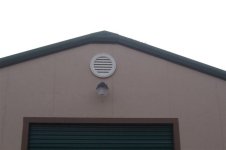ovrszd said:
Eddie you were doing so good with a detailed, hair splitting, techno explanation!!! Then you made the statement about the air temp being the same inside as outside as a fix. How would that solution work in a shop that is heated??

Hey Ovrszd,
When the shop is heated, the outside temps are now cooler than the inside temps. This will cause the formation of condensation on the outside of the roof. If you were to go outside late at night or early in the morning, you'll see this all over the place. The roof and hood of your car does it all the time.
There is a formula as to how much water the air will hold based on the tempature of the air. Warm air will hold more water than cold air. If it's a dry climate, there isn't going to be much water in the air and you have very low humidity. Areas with lots of moisture and high temps get high humidity because the air will hold large quantities of moisture.
When the air is cooled, like the soda can example, you get condensation because the air can no longer hold the level of water it is holding. The soda can is cold enough to change the tempature of the air imediately surrounding itself. A warm soda will not have any change. There is a point for the air tempature and the soda can that will cause this. I forget the term, but at this point, humidity turns into condensation.
Fog is the same thing, but on a much larger scale. The ground lowers the air tempature to the point of 100% humidity and condensation forms on the surface of everything.
I'm also of the opinion that your slab has absolutely zero affect on condensation in a building. I'm in the extreme minority here to the point I might be the only person here who thinks this. My reasoning is very simple. To believe that water vapor travels up from the dirt under a slab, means that there has to be moisture under the slab. I've demolished quite a few concrete slabs on one kind or another over the years, and have never found one with moist dirt underneath them. In fact, the soils is so dry, it's almost as hard as the concrete. The other reason I don't believe moisture is traveling through 4 to 6 inches of concrete is that it wont' travel down through it. Pour water on the slab and wait for it to leak through. It's not gonna happen. If standing water wont' travel downhill through concrete, it aint gonna travel uphill through it. Espesially if theres no moisture under the slab to begin with. From what I understand, the reason for a vapor barrier under a slab is to hold the moisture in when pouring the slab. Once it's poured, the vapor barrier does nothing.
Venting the inside of the building will equalize it with the outside tempature. This will stop the formation of condensation. But if it's foggy outside, than it will be foggy inside.
Heating the inside will stop condensation from forming on the inside also, but it's an expensive fix. Circulating the air will help, but only to a limited degree unless you have vents. With vents, you can still circulate the air, but I don't know if it will make a difference or is needed.
Condensation will also form in the attics of wood built homes. This is the reason for attic vents. Some people think attic vents are to cool off the attic, but from what I've read, they make no difference in the amount of heat you have in your attic. They are there to equalize the outside tempature to the inside and cut down on the amount of condensation you get in your attic. It will not eliminate it, but the average home can survive without any problems with the minimal ammount of condensation that it gets every year.
Eddie

